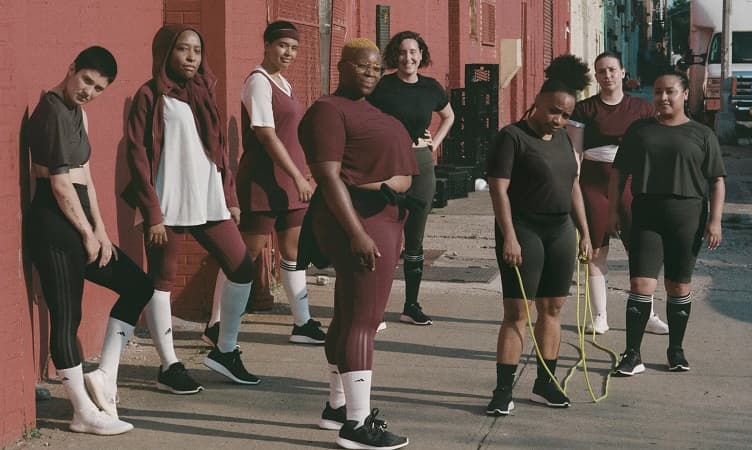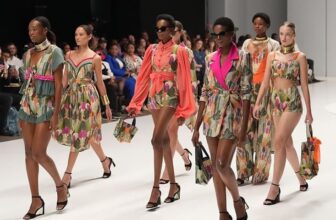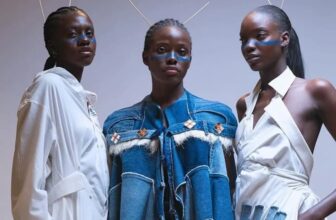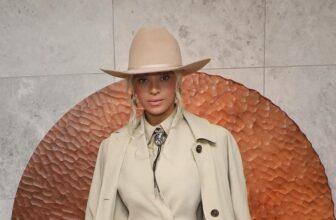In recent years, there has been a growing demand for greater size inclusivity in the fashion industry. Consumers have been calling for a wider range of sizes in clothing, from petite to plus size, and for brands to embrace diversity and inclusivity in their marketing campaigns.
In the past, fashion used to be solely focused on slim figures, causing exclusion and self-esteem concerns for individuals who didn’t fit the mold. This lack of inclusivity posed a challenge for many people who didn’t meet the standard size requirements for certain styles. However, the modern ready-to-wear industry is undergoing a transformation. Not only are they striving to create fashion that is environmentally and ethically responsible, but they are also placing a strong emphasis on embracing diversity and size inclusivity.
As per the insights from Fashion Network, the concept of size-inclusivity transcends the mere expansion of clothing sizes and categorizing bodies into fruit analogies like apples or pears. Instead, it celebrates the magnificently diverse human form as a collection of unique masterpieces. Size-inclusive brands embrace the spectrum of sex, gender, ethnicity, body shape, height, and abilities, harmonizing them to forge fashionable trends that cater to all individuals.
Across runway domains and promotional campaigns, plus-size women have claimed their space, leading to the emergence and revival of empowering movements like “body positivity.” Prominent luxury brands and fast fashion labels alike have embraced and celebrated curvier figures, making them new icons of style. As a result, retailers have expanded their size offerings, introducing sizes beyond 50, and created collections that embrace and honor size inclusivity.

What is size inclusivity in fashion?
Size inclusivity in fashion refers to the practice of designing and creating clothing that caters to a diverse range of body sizes and shapes. Its goal is to foster inclusiveness and diversity within the fashion industry by offering a wide array of clothing options that embrace different body types, rather than adhering to traditional or limited beauty standards. This concept addresses the longstanding issue of limited size ranges in fashion. Historically, many fashion brands and designers have primarily focused on producing clothing for smaller sizes, inadvertently neglecting or marginalizing individuals who do not fit into the standard sizing categories. This approach has contributed to body image concerns and limited choices for people with larger bodies.
In recent times, there has been a growing call for size-inclusive fashion, as people have become more vocal about the necessity for greater representation and diversity in clothing options. This movement has been fueled by body positivity activists, consumers, and plus-size models who have championed inclusivity within the fashion industry. Consequently, numerous fashion brands and designers have responded to this demand by expanding their size ranges to include larger sizes and introducing dedicated plus-size or extended-size lines. Additionally, some brands have taken strides towards using a more diverse range of models to showcase their clothing, thereby representing a broader range of body types.
There has also been a rise in independent and specialized brands that prioritize size inclusivity. These brands focus on designing clothing for a variety of body shapes and sizes, challenging the conventional beauty standards prevalent in the fashion industry. The pursuit of size inclusivity in fashion extends beyond merely expanding size ranges. It encompasses creating designs that flatter different body types, involving inclusive fit models in the design process, and considering the unique preferences and requirements of customers with diverse bodies.
Also, inclusive marketing and advertising campaigns have played a crucial role in promoting size inclusivity in fashion. Brands that feature a diverse range of body sizes and shapes in their marketing materials help to normalize different body types and challenge societal beauty norms.
While significant strides have been made in achieving size inclusivity in the fashion industry, there are still hurdles to overcome. These challenges include limited options for specific sizes within the plus-size range, inconsistent sizing standards across brands, and the need for greater representation of diverse body types in fashion media and on the runway. Since size inclusivity in fashion is a significant movement that acknowledges and celebrates the diversity of body sizes and shapes, it is only cool to offer unlimited clothing choices that make individuals of all sizes feel valued, confident, and empowered in their fashion decisions.
Factors that have contributed to size inclusivity in fashion
Size inclusivity in fashion has experienced a remarkable surge in popularity in recent years, as more brands and designers acknowledge the importance of representing diverse body types in their collections. In the early 2000s, most retailers only offered clothing sizes up to L or occasionally XL, and there were limited options for plus-size stores. During that time, the concepts of “body positivity” and “real beauty” were not as commonly discussed, and it was uncommon to see models above a size 0.
 Photo: Pexels/Roberto Hund
Photo: Pexels/Roberto Hund Today, size inclusivity has become an integral part of many fashion brands. Both budget-friendly retailers like Target and high-end fashion houses like Christian Siriano have expanded their clothing lines to cater to a wider range of sizes, providing more options for consumers. According to Vogue Business, the global plus-size clothing market is valued at $178 billion, with the US market alone worth $24 billion. Various factors have contributed to this level in the growth of the size inclusivity movement, bringing about positive transformations within the fashion industry.
Expansion of size ranges
Numerous well-known fashion brands have expanded their size options to embrace inclusivity. ASOS, H&M, and Old Navy are among the brands that have introduced plus-size lines, catering to a diverse range of body types. These brands have surpassed the conventional size boundaries, which traditionally ended at approximately size 12 or 14, by offering sizes extending up to 26 or even higher.
Dedicated size-inclusive brands
Alongside well-known brands extending their size ranges, there has been a notable rise in the emergence of independent and specialized brands dedicated to promoting size inclusivity. One such example is Universal Standard, a brand offering a wide range of clothing sizes from 00 to 40. Another notable brand is Premme, co-founded by plus-size influencers; Gabi Gregg, and Nicolette Mason, which aims to offer fashionable and trendy choices for sizes 12 and above.
Collaboration and partnerships
Collaborations between fashion brands and influential figures within the size inclusivity movement have been instrumental in promoting inclusivity. Like the partnership between renowned plus-size model Ashley Graham and the inclusive lingerie brand Addition Elle. Together, they have successfully developed a line of intimates, swimwear, and clothing. These collaborations effectively draw attention to the importance of size inclusivity and inspire other brands to embrace this mindset.
Body-positive activism
The movement advocates against determining self-worth based on physical appearance or perceptions of one’s own beauty. The body-positive movement, championed by body-positive activists, has been instrumental in challenging societal beauty standards and pushing for size inclusivity. Influencers like Tess Holliday, Gabi Gregg, and Iskra Lawrence have used their platforms to advocate for representation and diversity in the fashion industry, encouraging brands to offer more inclusive options.
Runway diversity
Fashion events and runway shows are now embracing size inclusivity by incorporating models of diverse sizes and body types. The inclusion of plus-size models in prominent fashion weeks, like New York Fashion Week, has played a significant role in dispelling stereotypes and presenting clothing on bodies that better represent the diversity of consumers.
Inclusive campaigns
These ads and marketing efforts involve featuring models with diverse body types and sizes in their advertising campaigns while embracing unretouched images that portray clothing realistically. An example is Dove’s “Real Beauty” campaign, which celebrated the beauty of different body types and challenged traditional beauty standards. Similarly, in 2017, Aerie, an American women’s underwear company, launched its “AerieReal” campaign.
This empowering initiative made a commitment to refrain from digitally altering or retouching their models’ appearances. By doing so, they aimed to promote body positivity and embrace natural features like cellulite, stretch marks, and fat rolls. Aerie also took a step further by including body-positive influencers and plus-sized models in their photo shoots and advertising campaigns.
Recognizing the demand for size inclusivity, the brand introduced a plus-size clothing line. In 2019, Decathlon joined this movement by launching its own campaign called “#LeggingsForEverybody.” Their mission was clear—to bolster body confidence and offer support to individuals on their unique fitness journeys. By encouraging inclusivity and embracing diverse body types, Decathlon aimed to inspire people from all walks of life to feel comfortable and empowered in their workout apparel.
Improved fit and design
In the fashion industry, designers and brands are dedicating resources to extensive research and development. Their goal is to ensure that clothing not only fits but also flatters a diverse range of body types. To achieve this, they enlist fit models from various size ranges who provide valuable insights into creating inclusive designs that consider the unique needs of different body shapes. By prioritizing fit and design, these efforts result in size-inclusive clothing that is both comfortable and stylish, tailored to meet the preferences and requirements of all customers.
Luxury brands, typically influential in setting mainstream trends, have more recently started recognizing the importance of inclusive sizing as a priority. It is worth noting that bodies of all sizes and shapes have always existed, although the fashion industry often attempts to create an illusion that larger bodies are a new phenomenon. This diversionary tactic deviates attention from the intentional exclusion of those who wear sizes beyond the standard range, like size 30 compared to size 2.
Leading the way among the “size-inclusive” brands are Universal Standard, offering models ranging from 00 to 40, and Good American, providing jeans from 00 to 24. While the number of brands currently embracing the ethical importance of catering to all sizes may be limited, the practice is expected to gain traction and become more widespread in the near future.
Featured Image Credit: Old Navy






